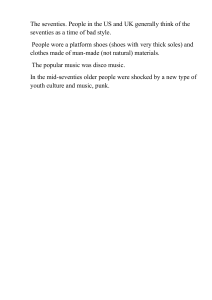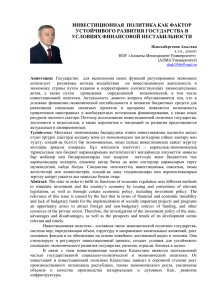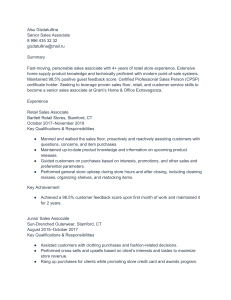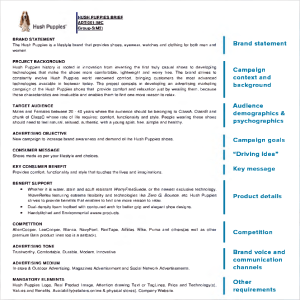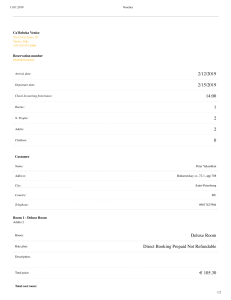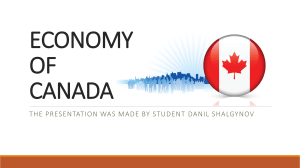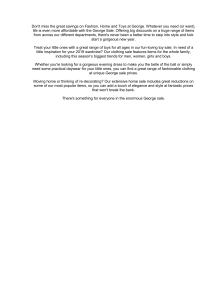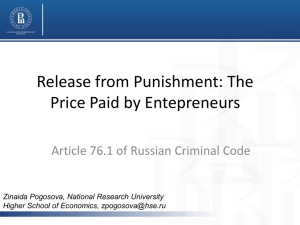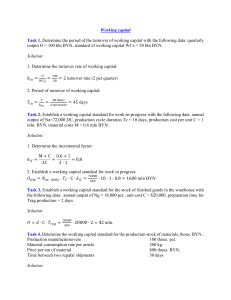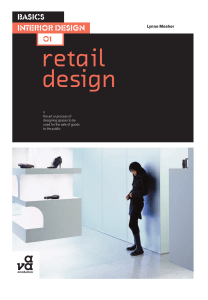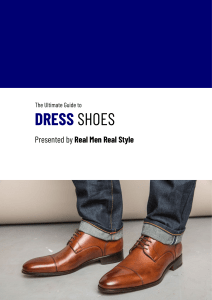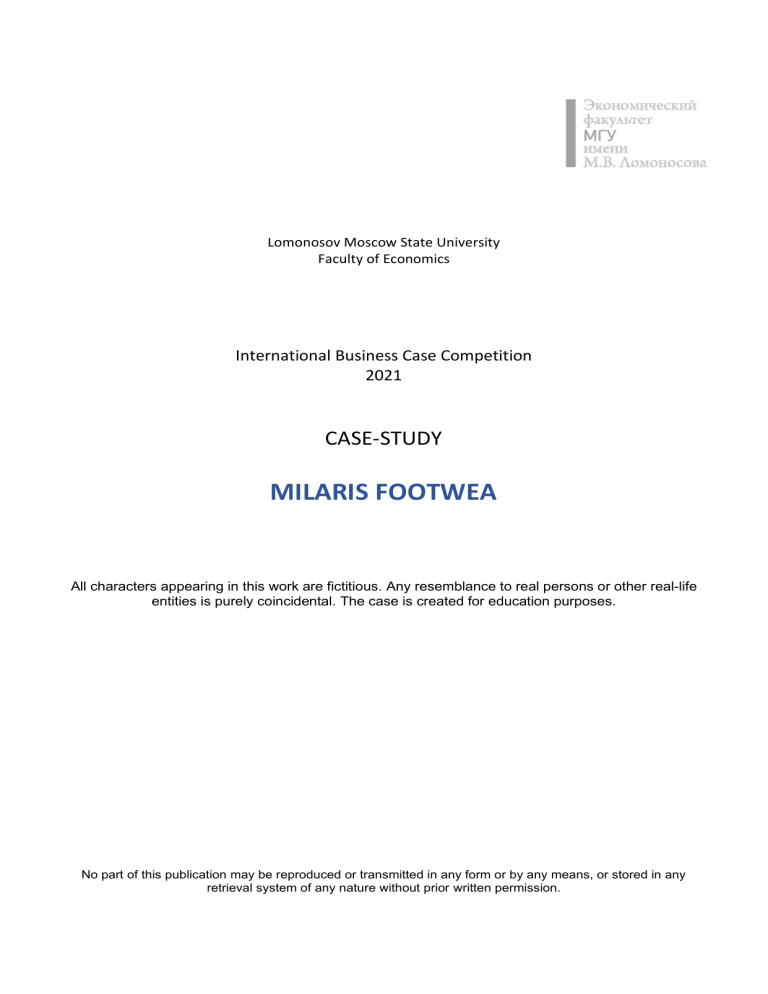
Lomonosov Moscow State University Faculty of Economics International Business Case Competition 2021 CASE-STUDY MILARIS FOOTWEA All characters appearing in this work are fictitious. Any resemblance to real persons or other real-life entities is purely coincidental. The case is created for education purposes. No part of this publication may be reproduced or transmitted in any form or by any means, or stored in any retrieval system of any nature without prior written permission. 1. MILARIS LTD BACKGROUND Milaris Ltd is a family owned footwear business, based near St.Petersburg, Russia. The company was established 25 years ago by husband and wife, Mikhail and Larissa. The name of the company represents a combination of first letters of its founders. Milaris was started as a producer of leather shoes for children. After 20 years it became a well-established business, offering a high quality, mid to high-end priced leather shoes not only for children, but also for men and women. Now Milaris shoe range covers all four seasons and includes: • Women’s Collection – sandals, loafers, sneakers, winter boots, rubber boots and office shoes • Men’s Collection - loafers, city line, evening, boots and driving shoes • Children’s Collection – sneakers, boots, ballet pumps, deck shoes, sandals and special collection for school For each seasonal collection Milaris produces 250 models in average. Company timeline 1995 – Mikhail and Larissa started manufacturing a small rage of children’s leather shoes from their summer house. They were looking for additional income, as the state-owned shoe factory, where they worked since graduating from college, suffered through difficulties and delays with paying salary occurred every other month. During that time consumer markets in Russia were still unsaturated and everything that was produced was easily sold. After the first month of running the business they have decided to quit their jobs and devoted all their time to family business. Mikhail was responsible for production and sales, and Larissa was responsible for design. 1998 - After three years of steady growth through word of mouth, Mikhail and Larissa bought a factory building near St.Petersburg city using their savings. Increased production capacity allowed Milaris to widen a product range and introduce men’s and women’s collections. By that time Milaris had a contract with only one wholesaler with little amounts of sales through their small factory shop. 2000 – Kirill, a nephew of Mikhail and Larissa, has joined Milaris as a Marketing Director, after completing a master degree in marketing at one of the leading universities in Russia. Kirill suggested to increase sales through new distribution channels. He created a mail-order catalogue which he inserted in a local magazine. This gave Milaris a steady increase in customers and demand for their footwear range. Catalogue supported the increase in brand awareness and Milaris began to get orders from various shops located in St.Petersburg and suburbs. 2004 - Milaris launched a website and gave customers the option to order online. Expansion of sales geography, brand is presented in 20 regions of Russia. 2006 - Milaris ordered specialist computer aided manufacturing (CAM) machinery from Japan and scoured the EU looking for other redundant but still fully usable footwear manufacturing equipment. This search proved very successful as Milaris was able to buy first-class, timeless manufacturing equipment at bargain prices from Germany. 2006 - 2010 - Milaris continued to introduce new products into its collection. 2010 - 2018 Milaris opened up its first retail outlet in St.Petersburg followed by other retail stores in 30 regions of Russia. 2018 – Milaris decided to expand to other regions in Russia by introducing its own retail franchise, however not many expressed the interest in becoming a franchisee. That was partly due to low brand awareness in other regions of Russia, where company was not presented. 2019 - Milaris invested heavily in updating its CAM and IT systems in order to be more flexible in its manufacturing and online processes. Ownership • Mikhail Ivanov – Managing Director (owns 40%) • Larissa Ivanova – Director of Production&Design (owns 40%) • Kirill Ivanov– Marketing Director (owns 20%) Current business model overview 2 Milaris’ reputation has grown over the years due to its strong vision and principles. In 2014 despite currency exchange crisis, Milaris survived, when many other Russian footwear manufacturers went into liquidation. Kirill feels that one of the main reasons Milaris survived was because it continued sourcing its materials from suppliers in the Russia. Meanwhile many other manufacturers sourced their material from Chinese suppliers as they were cheaper. Nowadays Milaris’ business comprises two sales avenues: retail outlets in 30 regions; and online and catalogue operations: • Retail outlets - Milaris has 40 retail outlets throughout Russia. • Online and catalogue – Milaris’ website and catalogue only sell Milaris products. Sales On average a pair of Milaris’ shoes is sold at a price of 5180Rubles. Some of its shoes are considered to be more ‘high-end’ and are priced at a higher rate, while others are sold at a lower price, such as children’s shoes. In the year ending December 2019, Milaris sold just under 480,000 pairs of shoes. Advertising and marketing Milaris like many other footwear companies spends a sizeable proportion of its revenue on advertising and marketing. This includes: • advertising in federal newspapers and women-interest magazines to try and raise the profile of the company and its products; • exhibiting at specialist events and trade fairs; and • producing quarterly promotional leaflets, which are sent to their loyal customers. Current customers A major share of Milaris customers are professional women (72%), they buy high-quality shoes for themselves, their children and guide purchasing of other family members. Their income is above average. Milaris spilt its customers into two categories. • Loyal customers – a majority of customers who buy footwear on a regular basis. Feedback shows that these customers are completely satisfied with all aspects of Milaris’ products, from design to price and quality. • Needs-based customers - these are less frequent customers who are product-specific and tend to buy items for which they have a defined need eg, winter shoes ahead of a winter season. These customers are known to be the highest users of Milars’ online search facilities. Both of these types of customers have different buying habits and need to be managed differently. Loyal customers are more likely to visit the outlets to get a full customer experience, whereas needs-based customers tend to buy online. Identification of these online customers, with the intention of converting them into loyal customers, is crucial in helping Milaris to grow. Milaris mission and vision Our mission is to be a top-quality Russian shoe manufacturer. We offer a wide range of high-end, leather, comfortable and formal footwear for men, women and children. We strive to keep our customers satisfied with every pair of shoes they wear. Trust is a key principle in our relations with customers, suppliers, and employees. Sustainability is at the heart of what we do. Our visions • We aim to work with our suppliers to source Russian materials where possible. • We aim to work and liaise with local communities to promote shoe manufacturing in Russia. • We aim to offer all employees the chance to participate in a full professional development programme. • We aim to be active in the development of annual footwear trade conferences and the promotion of factory visits to build product awareness among suppliers, manufacturers and customers. 3 2. MILARIS’ OPERATIONS Milaris invests in non-current assets in order to maintain and improve its production process and its ability to make sales. Milaris’ shoes have been made in the same traditional way since the company started, using high quality materials and specialised components. It is not only the quality of the materials and attention to detail, Milaris also offers a premier service to customers within its retail outlet stores. Design and development Design and development is an essential part of Milaris production process. They start with reviewing different design specifications and speaking to suppliers to source any materials that are required. Once the design has been approved, testing is arranged. Selections of employees take a pair of the prototype shoes and test all areas of fitting, design and comfort. After any necessary adjustments to the design, a final sample pair is produced. Before ordering any materials and starting on production, a final check is completed and is approved by Milaris directors. Materials and suppliers Raw materials are subject to rigorous control and continuous research. Milaris keeps an active eye on its suppliers and their products, making regular visits to suppliers’ premises to ensure good working relationships and to maintain top-quality standards of supplies. Suppliers have been chosen and supply routes established based on quality, service, price and regional factors. Milaris will only buy first-class materials and will only do business with suppliers who can offer a speedy re-ordering and re-stocking procedure at a fair and consistent price. Milaris expects all suppliers to maintain high standards when producing any of its products. Milaris also specifies that any suppliers who do not produce materials in-house, must source alternative production from within the Russia where possible. In return, Milaris is prepared to negotiate reasonable prices and offer long-term contracts to help suppliers commit to the delivery of quality products, which are made from Russia sources only. Milaris currently operates with four key, long-established suppliers who are fully aware of Milaris policy of wanting to ensure that its products are made from superior materials. Factory capacity In a normal 40-hour working week on normal production, the factory has the capacity to produce approximately 11,000 pairs of shoes. If a higher level of production is required, overtime is arranged across the whole production process. These short-term arrangements can produce up to 10% more shoes per week. Milaris currently produce just over 480,000 pairs of shoes a year. Factory workforce Milaris has 155-165 factory workers, including an intake of school-leavers as apprentices who form approximately 7% of the factory staff. Milaris is seen as an organisation that over the years has created, developed and maintained local skilled workers. Many of the employees have worked at Milaris for over 20 years, with several sons and daughters working alongside their parents. The workforce feels it is part of local manufacturing heritage. As a result of this strong sense of belonging, there is always a positive response when the need arises for overtime. Quality control Milaris has a comprehensive set of quality control procedures throughout its production process. During manufacturing, strict supervision over quality is maintained but the major component in quality control is the production workforce itself. Milaris’ employees take pride in the quality of their work and set their own high standards. They want to be recognized for producing top-quality shoes as they are well aware of the competition from other Russia manufacturers and abroad. They understand that any slippage in quality might have a serious impact on the company and their jobs. Shoes undergo a quality control check before going to be packed, ready for dispatch to the customer or retail outlets. 4 Factory costs per pair of shoes Pair of Shoes, Rubles Approximate labour costs Approximate materials costs Approximate factory overheads Total 800 1 390 194 2 384 Distribution Milaris’ integrated point-of-sale and inventory system ensures that, when a customer buys a pair of shoes, the local and central inventory records are updated and any necessary re-ordering is set in process. If a customer orders a pair of shoes which is not available in that outlet and the shoes are available centrally, they can be dispatched to a store or the customer’s home address within 24 hours. Milaris operates a regular, high-speed re-stocking operation for the retail outlets through its own fleet of vehicles. When required, it uses a national courier service if a re-stocking visit to a retail outlet cannot be managed by its own distribution service. Location Milaris has a good geographical coverage (see map below). When opening a new outlet, Milaris has a number of geographical criteria. Region – ensuring good national coverage. Prefer capitals of federal districts or big cities in a selected region. Proximity – not close to another Milaris outlet, to prevent any infringement on other outlets. Quality – Milaris locates its stores only in upmarket popular shopping centres, high end out-of-town malls or high streets in affluent areas. Competition – Milaris ensures that the area is not surrounded by too many of its competitors. Size and fitting Milaris preferred size for its retail outlets is around 70 square metres. This provides enough room for a reasonably large shop area, together with a space for controlled inventory storage of a comprehensive range of its most popular footwear. Milaris outlets are fitted out to a common design and theme, which is updated and renewed at least every five years. They are fitted with the latest shoe fitting equipment, which registers all customer records for future reference. When an existing outlet undergoes a major refurbishment, it is necessary to close that outlet for a period of two weeks. During this time staff are temporarily re-located to other outlets or involved in training and development. Staffing and training Outlets are open a minimum of 57 hours per week. To cover these hours Milaris employs at each outlet: • a minimum of three full-time shop workers to help customers during shop opening hours. These are employed on a basic 40 hour week; and 5 • a minimum of four part-time shop workers for specific days or times such as weekends or late openings, or to cover holidays and other times of staff shortages. Part-time staff are always offered the opportunity to become full-time staff whenever a vacancy occurs. Milaris puts all new retail staff through a training programme. Quarterly updates are given to all staff, which informs them of any new products or changes in the business. Milaris prides itself on staff that have a consistently high standard of interpersonal and technical skills; offering customers a top-quality service is a vital part of Milaris’ values. Target sales All outlets must aim to sell a minimum of 720 pairs of shoes every month (allowing for public holidays or exceptional events in any single week) in order to be considered viable. When any new store opens, its target sales are set at 75% for the first 12 months of operating to give the store time to build customer relationships and reputation. Retail outlet costs (per outlet) Retail outlet costs (per outlet), mln. Rubles Average annual cost of running a shop Average retail premises eg, rental, electric, insurance, other costs Average retail outlet labour cost Total 28 14 11 53 3. MILARIS’ ONLINE AND CATALOGUE OPERATIONS Online sales Since Milaris launched its website in 2004, online sales have become a significant part of its business; in the 2019 accounts, approximately 20% of Milaris’ total annual sales were from online sales. Milaris does not sell any of its products through other retail websites. Catalogue sales The revenue attributed directly to customers buying through Milaris’ catalogue is currently around 4% of total sales. Although this as a percentage is falling slowly, the absolute amount of specific sales through the catalogue remains around Rub 120m annually. Although the revenue generated by the catalogue appears small, Milaris has never considered abandoning it. The catalogue is seen as an important way to advertise its products, particularly to older customers. Milaris considers it an important marketing document that helps increase sales across all outlets, as well as providing a doorway to online sales. It appears, for example, that many older customers visit the retail outlets to buy their footwear in a shop having first seen them in the catalogue. Distribution When a customer buys a pair of shoes online or through the catalogue, they can either collect them from Milaris’ nearest retail outlet or select free home delivery. Offering customers both options has proven to be popular. More customers are now choosing the option for home delivery as it is more convenient to their lifestyle. Due to the shift of more customers buying online, Milaris’ distribution costs have risen significantly. Milaris uses a national courier service for the majority of home deliveries, where customers have to sign to receive goods. This service offers customers a limited number of delivery attempts before they are instructed to collect the goods from the courier’s local depot. Milaris has received a few complaints about this process from their older customers who do not drive. 6 4. COMPETITORS There are a number of strong footwear manufacturers, suppliers and retailers in Russia. Top 10 footwear retailers are listed below. # Competitor 1. 2. 3. 4. 5. 6. 7. 8. 9. 10. Kari Shoes of Russia Unichel Zenden Group BELWEST Monro Respect Carnaby/TJ/Chester Ralf Ringer Econica Nubmer of Outlets Sales revenue, mln. Rubles 1240 40 000 869 11 550 623 3 269 409 27 000 403 786 300 n/a 250 2 350 209 n/a 191 6 000 131 5 360 Source: https://marketmedia.ru/media-content/top-10-obuvnykh-setey-/, additional information could be found on competitor’s web-sites. 7 5. MILARIS MANAGEMENT ACCOUNTS Income statement Revenue (Note 1) Factory costs (Note 2) Gross profit Distribution costs (Note 3) Selling expenses (Note 4) Administrative expenses (Note 5) Operating profit Net finance (expense)/income Profit before taxation Taxation (20%) Profit for the year after taxation 2019 (Rubles, mln) 3 110 (1 269) 1 841 2018 (Rubles, mln) 2 927 (1 155) 1 772 (248) (211) 17,5 (1 128) (1 053) 7,1 (454) 11 (413) 95 10,0 -88,4 (2,5) (1,4) 78,6 8,5 (1,7) 93,6 (18,72) -90,9 -90,9 6,8 74,88 -90,9 (%) 6,3 9,9 3,9 Note 1: Distribution of revenue 2019 (Rubles, mln) Men’s shoes Women’s and children’s shoes 2018 (Rubles, mln) 951 2 159 3 110 (%) 923 3,0 2 004 2 927 7,7 6,3 Note 2: Factory costs 2019 (Rubles, mln) Factory wages Materials Manufacturing overheads 2018 (Rubles, mln) (%) 452 718 410 654 10,2 9,8 99 1 269 91 1 155 8,8 9,9 Note 3: Distribution costs 2019 (Rubles, mln) Delivery vehicle running costs (fuel etc) Distribution overheads and salaries Courier and related delivery services 2018 (Rubles, mln) (%) 377 361 4,4 579 515 12,4 2,151 248 1,763 211 22,0 17,5 8 Note 4: Selling expenses 2019 (Rubles, mln) Retail outlets Retail outlet costs Refurbishment depreciation and loss on disposals Retail outlet wages Web and IT Web costs Computer & IT running costs IT depreciation and loss on disposals Total selling expenses 2018 (Rubles, mln) (%) 498 462 7,8 69 362 929 54 342 858 27,8 5,8 8,3 128 119 7,6 39 38 2,6 32 199 1 128 38 195 1 053 -15,8 2,1 7,1 Note 5: Administration expenses 2019 (Rubles, mln) Design office and prototype costs 76 Marketing, advertising and catalogue 119 Administration staff salaries 110 Office costs including training 91 Legal and professional 31 Other 27 454 2018 (Rubles, mln) (%) 69 10,1 116 2,6 102 7,8 81 12,3 21 24 413 47,6 12,5 10,0 9 Statement of Financial Position 2019 (Rubles, mln) Non-current assets Tangible assets Current assets Inventories Accounts receivable Cash and cash equivalents Total assets Shareholders' equity Ordinary share capital Retained earnings Total shareholders' equity Current liabilities Accounts payable Bank overdraft Total current liabilities Total equity and liabilities 2018 (Rubles, mln) (%) 462 462 559 559 -17,4 -17,4 187 92 163 87 14,7 5,7 61 340 802 0,96 251 810 6254,2 35,5 -1,1 8 369 8 364 0 1,4 377 372 1,3 426 - 439 - -3,0 426 439 -3,0 803 811 -1.0 Analysis of Cash Flows 2019 (Rubles, mln) Cash at start of year Movement in cash during year: Cash in Cash from operations Proceeds from disposal of noncurrent assets Cash out Finance costs Purchase of noncurrent assets Tax paid Total movement in cash during year Cash at end of year 2018 (Rubles, mln) (%) 0,96 -1,12 185,7 134 306 -56,2 1,9 4,5 -57,8 -2,5 -1,4 79 -82,7 -49 -23,2 -283 -24,1 61,2 62,16 2 0,88 -3,7 6964 10 YOUR TASK During their last meeting Mikhail, Larissa and Kirill were discussing, that they have to develop a new strategic plan for the next five years. Everyone agrees that their main goal should be to continue growing. Larissa is convinced, that Milaris has to continue growing locally, however Kirill thinks that this is a good time to expand internationally and look for international partners. Which of these two options Milaris has to choose and which changes Milaris has to undergo? Please, provide your in-depth recommendations and consider the following aspects as part of this: • risks • ethics • finance • benefits • operations • company strategy and policy. While preparing your recommendations be also aware of: • how your recommendation fits with Milaris current mission, vision and values; • any earlier decisions/other history of relevance that may impact the progress; • the key points which support the recommendation; and • the public relations implications, if any. 11
